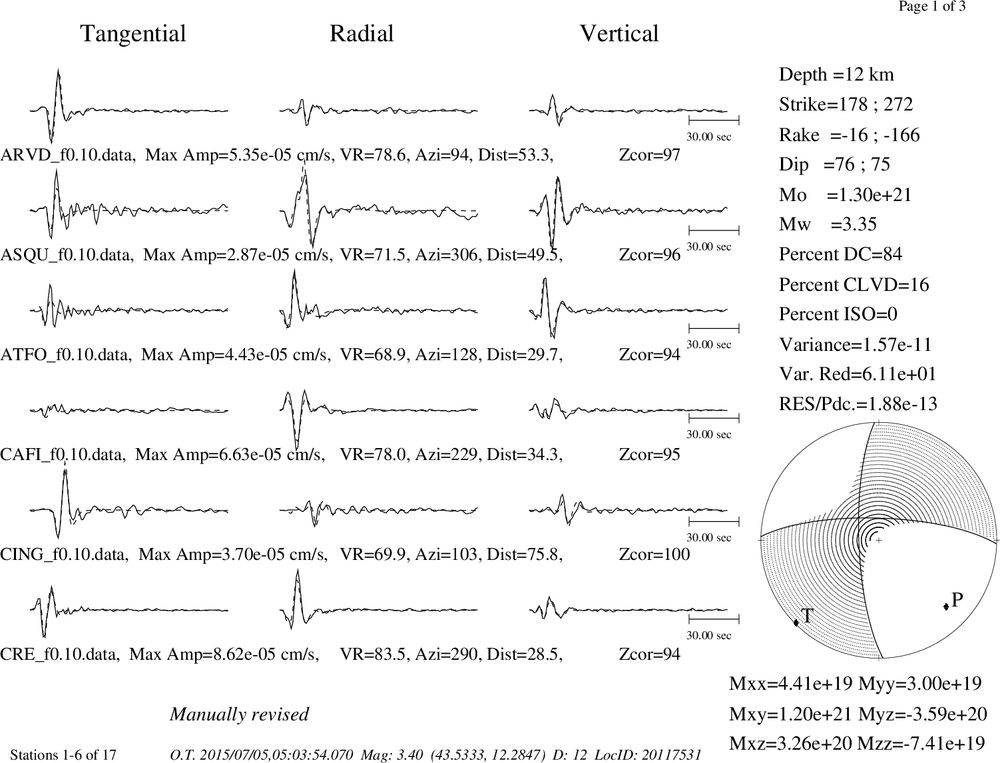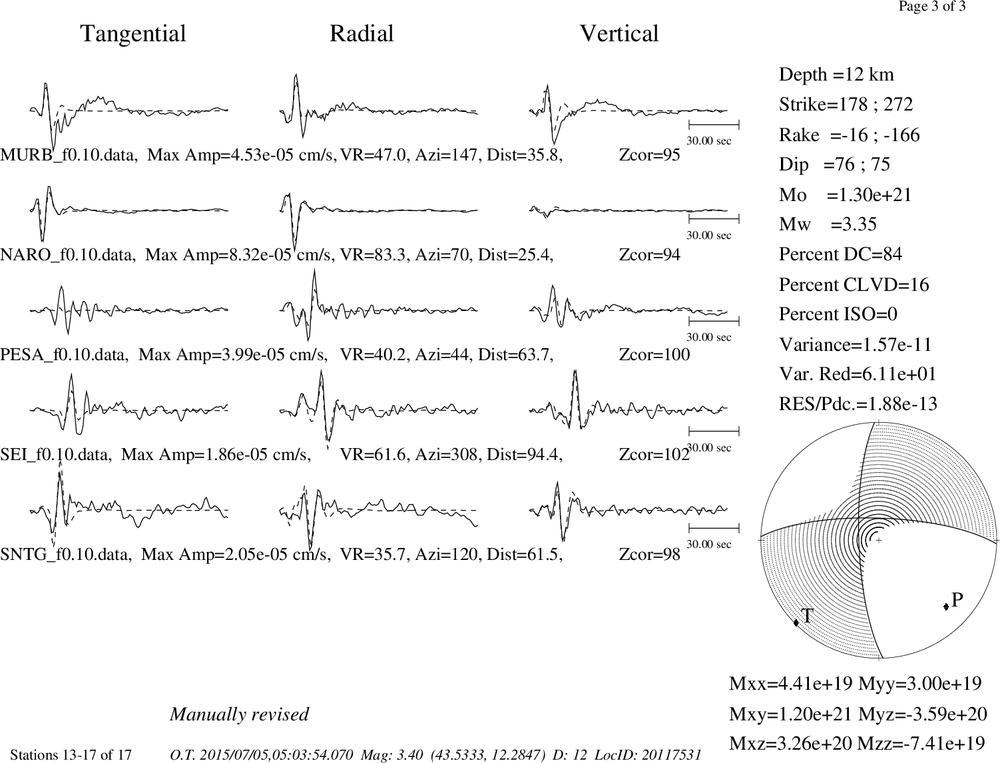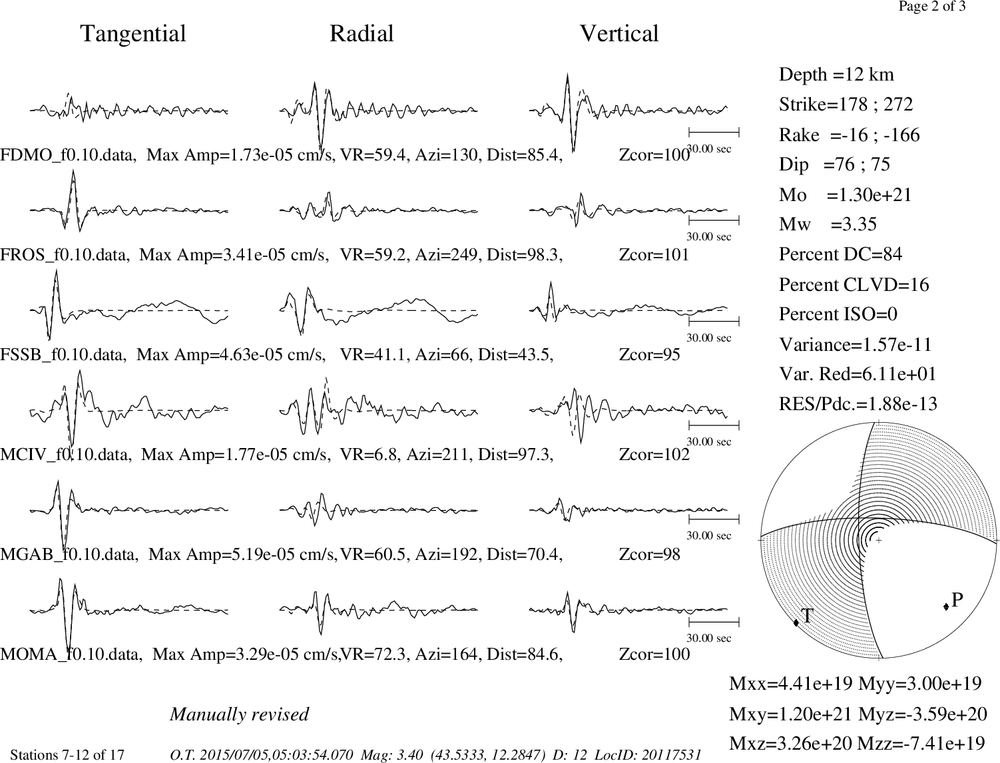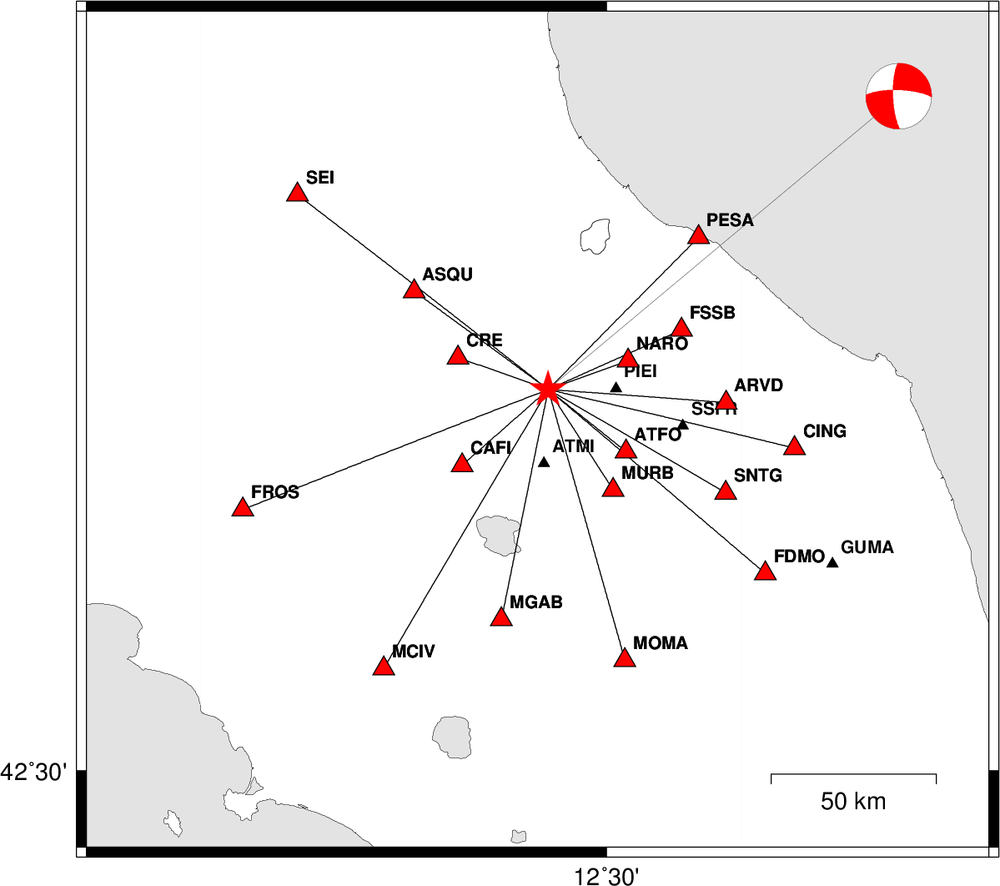Location
2015/07/05 05:03:54 43.53 12.28 12.0 3.4 Italy
Arrival Times (from USGS)
Arrival time list
Felt Map
USGS Felt map for this earthquake
USGS Felt reports page for
Focal Mechanism
SLU Moment Tensor Solution
ENS 2015/07/05 05:03:54:0 43.53 12.28 12.0 3.4 Italy
Stations used:
GU.CARD GU.MAIM IV.AOI IV.ARCI IV.ARVD IV.ASQU IV.ATFO
IV.ATMI IV.ATVO IV.BDI IV.CAFI IV.CAMP IV.CASP IV.CERT
IV.CESX IV.CING IV.CRE IV.CRMI IV.FDMO IV.FIAM IV.FIR
IV.FNVD IV.FROS IV.FSSB IV.GROG IV.GUMA IV.LMD IV.MA9
IV.MCIV IV.MGAB IV.MOMA IV.MSSA IV.MTCE IV.MTRZ IV.NARO
IV.OFFI IV.PARC IV.PESA IV.PLMA IV.POFI IV.PTQR IV.RMP
IV.SACS IV.SEI IV.SNTG IV.SSFR IV.TERO IV.TOLF IV.TRIF
IV.TRTR MN.AQU MN.VLC
Filtering commands used:
cut o DIST/3.3 -30 o DIST/3.3 +70
rtr
taper w 0.1
hp c 0.02 n 3
lp c 0.10 n 3
Best Fitting Double Couple
Mo = 1.29e+21 dyne-cm
Mw = 3.34
Z = 11 km
Plane Strike Dip Rake
NP1 272 71 -159
NP2 175 70 -20
Principal Axes:
Axis Value Plunge Azimuth
T 1.29e+21 1 43
N 0.00e+00 62 312
P -1.29e+21 28 134
Moment Tensor: (dyne-cm)
Component Value
Mxx 2.00e+20
Mxy 1.14e+21
Mxz 3.83e+20
Myy 8.35e+19
Myz -3.72e+20
Mzz -2.83e+20
-----#########
--------##############
----------################ T
-----------################
------------######################
-------------#######################
--------------########################
---------------#########################
-------------##--------#################
-----###########------------------########
-###############-----------------------###
################--------------------------
################--------------------------
###############-------------------------
################------------------------
###############------------- -------
###############------------ P ------
##############------------ -----
#############-----------------
#############---------------
###########-----------
########------
Global CMT Convention Moment Tensor:
R T P
-2.83e+20 3.83e+20 3.72e+20
3.83e+20 2.00e+20 -1.14e+21
3.72e+20 -1.14e+21 8.35e+19
Details of the solution is found at
http://www.eas.slu.edu/eqc/eqc_mt/MECH.IT/20150705050354/index.html
|
Preferred Solution
The preferred solution from an analysis of the surface-wave spectral amplitude radiation pattern, waveform inversion and first motion observations is
STK = 175
DIP = 70
RAKE = -20
MW = 3.34
HS = 11.0
The NDK file is 20150705050354.ndk
The waveform inversion is preferred.
Moment Tensor Comparison
The following compares this source inversion to others
| SLU |
INGVTDMT |
SLU Moment Tensor Solution
ENS 2015/07/05 05:03:54:0 43.53 12.28 12.0 3.4 Italy
Stations used:
GU.CARD GU.MAIM IV.AOI IV.ARCI IV.ARVD IV.ASQU IV.ATFO
IV.ATMI IV.ATVO IV.BDI IV.CAFI IV.CAMP IV.CASP IV.CERT
IV.CESX IV.CING IV.CRE IV.CRMI IV.FDMO IV.FIAM IV.FIR
IV.FNVD IV.FROS IV.FSSB IV.GROG IV.GUMA IV.LMD IV.MA9
IV.MCIV IV.MGAB IV.MOMA IV.MSSA IV.MTCE IV.MTRZ IV.NARO
IV.OFFI IV.PARC IV.PESA IV.PLMA IV.POFI IV.PTQR IV.RMP
IV.SACS IV.SEI IV.SNTG IV.SSFR IV.TERO IV.TOLF IV.TRIF
IV.TRTR MN.AQU MN.VLC
Filtering commands used:
cut o DIST/3.3 -30 o DIST/3.3 +70
rtr
taper w 0.1
hp c 0.02 n 3
lp c 0.10 n 3
Best Fitting Double Couple
Mo = 1.29e+21 dyne-cm
Mw = 3.34
Z = 11 km
Plane Strike Dip Rake
NP1 272 71 -159
NP2 175 70 -20
Principal Axes:
Axis Value Plunge Azimuth
T 1.29e+21 1 43
N 0.00e+00 62 312
P -1.29e+21 28 134
Moment Tensor: (dyne-cm)
Component Value
Mxx 2.00e+20
Mxy 1.14e+21
Mxz 3.83e+20
Myy 8.35e+19
Myz -3.72e+20
Mzz -2.83e+20
-----#########
--------##############
----------################ T
-----------################
------------######################
-------------#######################
--------------########################
---------------#########################
-------------##--------#################
-----###########------------------########
-###############-----------------------###
################--------------------------
################--------------------------
###############-------------------------
################------------------------
###############------------- -------
###############------------ P ------
##############------------ -----
#############-----------------
#############---------------
###########-----------
########------
Global CMT Convention Moment Tensor:
R T P
-2.83e+20 3.83e+20 3.72e+20
3.83e+20 2.00e+20 -1.14e+21
3.72e+20 -1.14e+21 8.35e+19
Details of the solution is found at
http://www.eas.slu.edu/eqc/eqc_mt/MECH.IT/20150705050354/index.html
|
|
Waveform Inversion
The focal mechanism was determined using broadband seismic waveforms. The location of the event and the
and stations used for the waveform inversion are shown in the next figure.

|
|
Location of broadband stations used for waveform inversion
|
The program wvfgrd96 was used with good traces observed at short distance to determine the focal mechanism, depth and seismic moment. This technique requires a high quality signal and well determined velocity model for the Green functions. To the extent that these are the quality data, this type of mechanism should be preferred over the radiation pattern technique which requires the separate step of defining the pressure and tension quadrants and the correct strike.
The observed and predicted traces are filtered using the following gsac commands:
cut o DIST/3.3 -30 o DIST/3.3 +70
rtr
taper w 0.1
hp c 0.02 n 3
lp c 0.10 n 3
The results of this grid search from 0.5 to 19 km depth are as follow:
DEPTH STK DIP RAKE MW FIT
WVFGRD96 1.0 190 60 30 3.03 0.3533
WVFGRD96 2.0 190 55 30 3.11 0.3896
WVFGRD96 3.0 175 50 -15 3.15 0.4180
WVFGRD96 4.0 175 55 -15 3.18 0.4719
WVFGRD96 5.0 170 50 -25 3.26 0.5153
WVFGRD96 6.0 170 60 -35 3.29 0.5627
WVFGRD96 7.0 170 60 -30 3.30 0.6013
WVFGRD96 8.0 175 65 -25 3.29 0.6278
WVFGRD96 9.0 175 65 -20 3.31 0.6422
WVFGRD96 10.0 175 70 -20 3.33 0.6500
WVFGRD96 11.0 175 70 -20 3.34 0.6538
WVFGRD96 12.0 175 70 -20 3.36 0.6531
WVFGRD96 13.0 175 70 -20 3.37 0.6486
WVFGRD96 14.0 175 70 -20 3.38 0.6401
WVFGRD96 15.0 175 65 -20 3.41 0.6283
WVFGRD96 16.0 175 65 -20 3.42 0.6168
WVFGRD96 17.0 175 65 -20 3.43 0.6040
WVFGRD96 18.0 175 65 -20 3.44 0.5906
WVFGRD96 19.0 175 60 -15 3.44 0.5764
WVFGRD96 20.0 175 60 -15 3.45 0.5619
WVFGRD96 21.0 175 60 -15 3.46 0.5469
WVFGRD96 22.0 175 60 -15 3.47 0.5314
WVFGRD96 23.0 175 60 -15 3.48 0.5161
WVFGRD96 24.0 170 55 -15 3.49 0.5012
WVFGRD96 25.0 175 60 -5 3.49 0.4873
WVFGRD96 26.0 175 60 -5 3.50 0.4749
WVFGRD96 27.0 175 60 -5 3.51 0.4629
WVFGRD96 28.0 175 60 0 3.52 0.4525
WVFGRD96 29.0 175 60 -10 3.53 0.4440
The best solution is
WVFGRD96 11.0 175 70 -20 3.34 0.6538
The mechanism correspond to the best fit is

|
|
Figure 1. Waveform inversion focal mechanism
|
The best fit as a function of depth is given in the following figure:

|
|
Figure 2. Depth sensitivity for waveform mechanism
|
The comparison of the observed and predicted waveforms is given in the next figure. The red traces are the observed and the blue are the predicted.
Each observed-predicted component is plotted to the same scale and peak amplitudes are indicated by the numbers to the left of each trace. A pair of numbers is given in black at the right of each predicted traces. The upper number it the time shift required for maximum correlation between the observed and predicted traces. This time shift is required because the synthetics are not computed at exactly the same distance as the observed and because the velocity model used in the predictions may not be perfect.
A positive time shift indicates that the prediction is too fast and should be delayed to match the observed trace (shift to the right in this figure). A negative value indicates that the prediction is too slow. The lower number gives the percentage of variance reduction to characterize the individual goodness of fit (100% indicates a perfect fit).
The bandpass filter used in the processing and for the display was
cut o DIST/3.3 -30 o DIST/3.3 +70
rtr
taper w 0.1
hp c 0.02 n 3
lp c 0.10 n 3

|
|
Figure 3. Waveform comparison for selected depth. Red: observed; Blue - predicted. The time shift with respect to the model prediction is indicated. The percent of fit is also indicated.
|

|
|
Focal mechanism sensitivity at the preferred depth. The red color indicates a very good fit to thewavefroms.
Each solution is plotted as a vector at a given value of strike and dip with the angle of the vector representing the rake angle, measured, with respect to the upward vertical (N) in the figure.
|
A check on the assumed source location is possible by looking at the time shifts between the observed and predicted traces. The time shifts for waveform matching arise for several reasons:
- The origin time and epicentral distance are incorrect
- The velocity model used for the inversion is incorrect
- The velocity model used to define the P-arrival time is not the
same as the velocity model used for the waveform inversion
(assuming that the initial trace alignment is based on the
P arrival time)
Assuming only a mislocation, the time shifts are fit to a functional form:
Time_shift = A + B cos Azimuth + C Sin Azimuth
The time shifts for this inversion lead to the next figure:

The derived shift in origin time and epicentral coordinates are given at the bottom of the figure.
Discussion
Velocity Model
The nnCIA used for the waveform synthetic seismograms and for the surface wave eigenfunctions and dispersion is as follows:
MODEL.01
C.It. A. Di Luzio et al Earth Plan Lettrs 280 (2009) 1-12 Fig 5. 7-8 MODEL/SURF3
ISOTROPIC
KGS
FLAT EARTH
1-D
CONSTANT VELOCITY
LINE08
LINE09
LINE10
LINE11
H(KM) VP(KM/S) VS(KM/S) RHO(GM/CC) QP QS ETAP ETAS FREFP FREFS
1.5000 3.7497 2.1436 2.2753 0.500E-02 0.100E-01 0.00 0.00 1.00 1.00
3.0000 4.9399 2.8210 2.4858 0.500E-02 0.100E-01 0.00 0.00 1.00 1.00
3.0000 6.0129 3.4336 2.7058 0.500E-02 0.100E-01 0.00 0.00 1.00 1.00
7.0000 5.5516 3.1475 2.6093 0.167E-02 0.333E-02 0.00 0.00 1.00 1.00
15.0000 5.8805 3.3583 2.6770 0.167E-02 0.333E-02 0.00 0.00 1.00 1.00
6.0000 7.1059 4.0081 3.0002 0.167E-02 0.333E-02 0.00 0.00 1.00 1.00
8.0000 7.1000 3.9864 3.0120 0.167E-02 0.333E-02 0.00 0.00 1.00 1.00
0.0000 7.9000 4.4036 3.2760 0.167E-02 0.333E-02 0.00 0.00 1.00 1.00
Quality Control
Here we tabulate the reasons for not using certain digital data sets
The following stations did not have a valid response files:
DATE=Tue Jul 7 10:48:29 CDT 2015
Last Changed 2015/07/05









